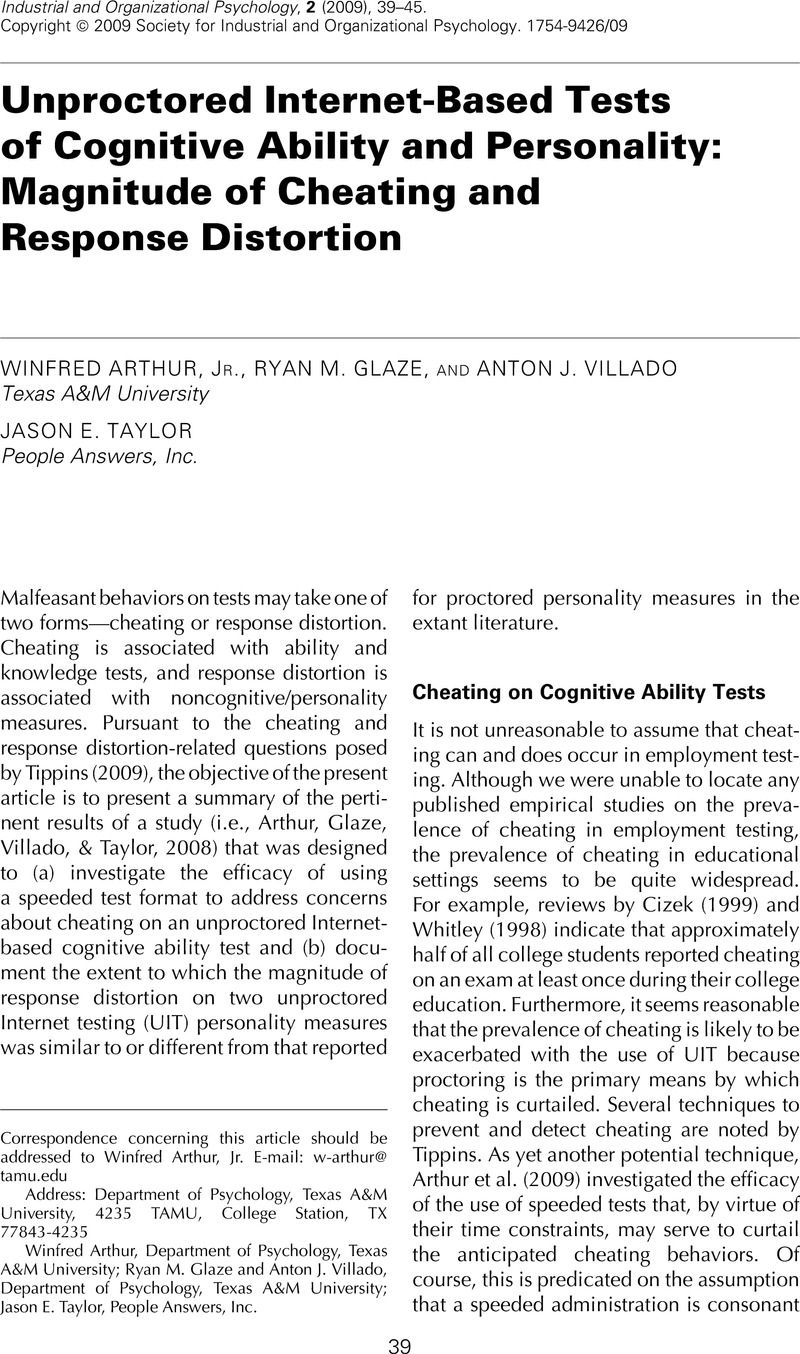Crossref Citations
This article has been cited by the following publications. This list is generated based on data provided by Crossref.
Reynolds, Douglas H.
Wasko, Laurie E.
Sinar, Evan F.
Raymark, Patrick H.
and
Jones, Joseph A.
2009.
UIT or Not UIT? That Is Not the Only Question.
Industrial and Organizational Psychology,
Vol. 2,
Issue. 1,
p.
52.
Drasgow, Fritz
Nye, Christopher D.
Guo, Jing
and
Tay, Louis
2009.
Cheating on Proctored Tests: The Other Side of the Unproctored Debate.
Industrial and Organizational Psychology,
Vol. 2,
Issue. 1,
p.
46.
Tippins, Nancy T.
2009.
Where Is the Unproctored Internet Testing Train Headed Now?.
Industrial and Organizational Psychology,
Vol. 2,
Issue. 1,
p.
69.
Guo, Jing
and
Drasgow, Fritz
2010.
Identifying Cheating on Unproctored Internet Tests: The Z‐test and the likelihood ratio test.
International Journal of Selection and Assessment,
Vol. 18,
Issue. 4,
p.
351.
Komar, Shawn
Komar, Jennifer A.
Robie, Chet
and
Taggar, Simon
2010.
Speeding Personality Measures to Reduce Faking.
Journal of Personnel Psychology,
Vol. 9,
Issue. 3,
p.
126.
Kim, Brian H.
2011.
International Review of Industrial and Organizational Psychology 2011.
p.
181.
Arthur, Winfred
and
Glaze, Ryan M.
2011.
Technology‐Enhanced Assessment of Talent.
p.
99.
Beaty, James C.
Nye, Christopher D.
Borneman, Matthew J.
Kantrowitz, Tracy M.
Drasgow, Fritz
and
Grauer, Eyal
2011.
Proctored Versus Unproctored Internet Tests: Are unproctored noncognitive tests as predictive of job performance?.
International Journal of Selection and Assessment,
Vol. 19,
Issue. 1,
p.
1.
Makransky, Guido
and
Glas, Cees. A. W.
2011.
Unproctored Internet Test Verification.
Organizational Research Methods,
Vol. 14,
Issue. 4,
p.
608.
Kim, Brian H.
2012.
International Review of Industrial and Organizational Psychology 2011.
p.
239.
Holladay, Courtney L.
David, Emily
and
Johnson, Stefanie K.
2013.
Retesting Personality in Employee Selection: Implications of the Context, Sample, and Setting.
Psychological Reports,
Vol. 112,
Issue. 2,
p.
486.
Konradt, Udo
Warszta, Tim
and
Ellwart, Thomas
2013.
Fairness Perceptions in Web‐based Selection: Impact on applicants’ pursuit intentions, recommendation intentions, and intentions to reapply.
International Journal of Selection and Assessment,
Vol. 21,
Issue. 2,
p.
155.
Karim, Michael N.
Kaminsky, Samuel E.
and
Behrend, Tara S.
2014.
Cheating, Reactions, and Performance in Remotely Proctored Testing: An Exploratory Experimental Study.
Journal of Business and Psychology,
Vol. 29,
Issue. 4,
p.
555.
Schmitt, Neal
2014.
Personality and Cognitive Ability as Predictors of Effective Performance at Work.
Annual Review of Organizational Psychology and Organizational Behavior,
Vol. 1,
Issue. 1,
p.
45.
Wright, Natalie A.
Meade, Adam W.
and
Gutierrez, Sara L.
2014.
Using Invariance to Examine Cheating in Unproctored Ability Tests.
International Journal of Selection and Assessment,
Vol. 22,
Issue. 1,
p.
12.
Tippins, Nancy T.
2015.
Technology and Assessment in Selection.
Annual Review of Organizational Psychology and Organizational Behavior,
Vol. 2,
Issue. 1,
p.
551.
Villado, Anton J.
Randall, Jason G.
and
Zimmer, Christina U.
2016.
The Effect of Method Characteristics on Retest Score Gains and Criterion-Related Validity.
Journal of Business and Psychology,
Vol. 31,
Issue. 2,
p.
233.
Barney, Matt
and
Fisher, William P.
2016.
Adaptive Measurement and Assessment.
Annual Review of Organizational Psychology and Organizational Behavior,
Vol. 3,
Issue. 1,
p.
469.
McCarthy, Julie M.
Bauer, Talya N.
Truxillo, Donald M.
Anderson, Neil R.
Costa, Ana Cristina
and
Ahmed, Sara M.
2017.
Applicant Perspectives During Selection: A Review Addressing “So What?,” “What’s New?,” and “Where to Next?”.
Journal of Management,
Vol. 43,
Issue. 6,
p.
1693.
Bartram, Dave
and
Tippins, Nancy
2017.
The Wiley Blackwell Handbook of the Psychology of Recruitment, Selection and Employee Retention.
p.
271.



